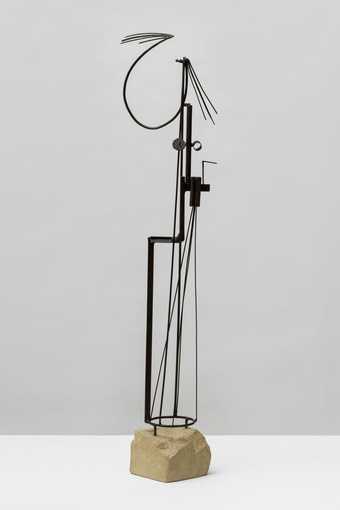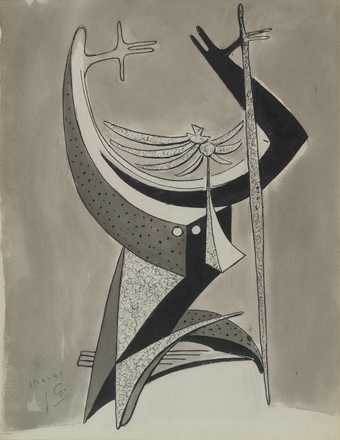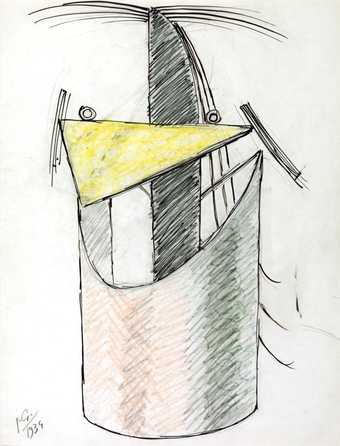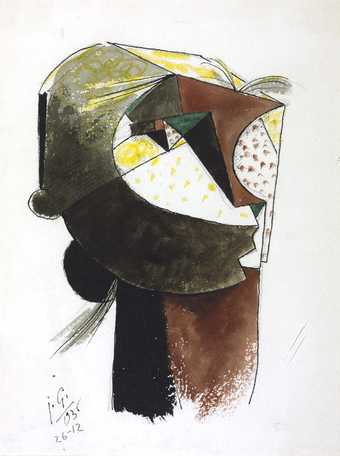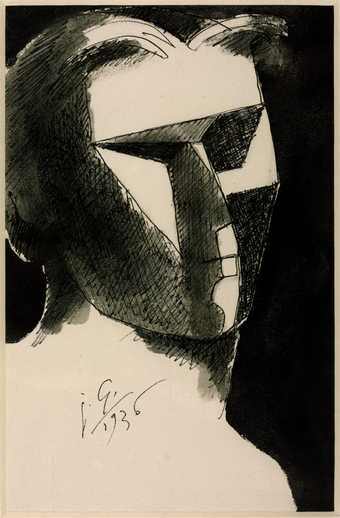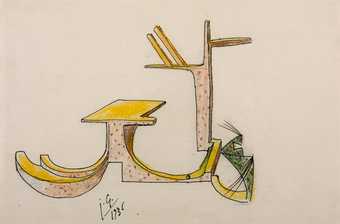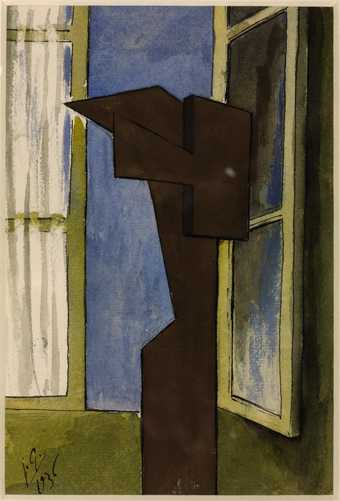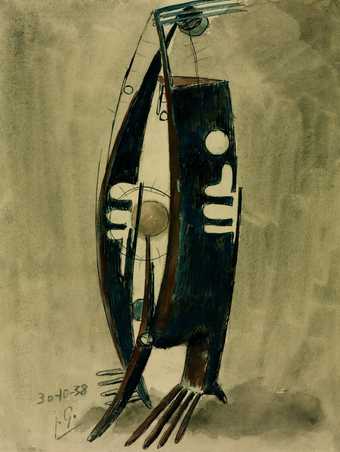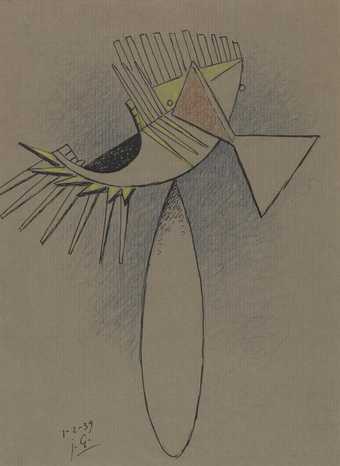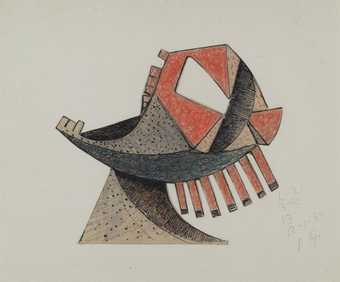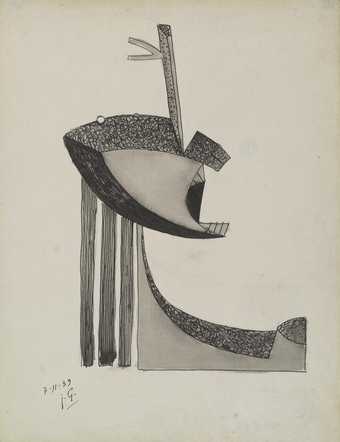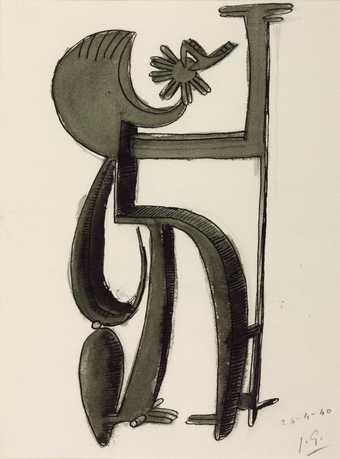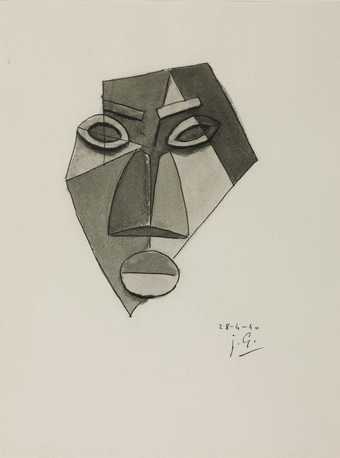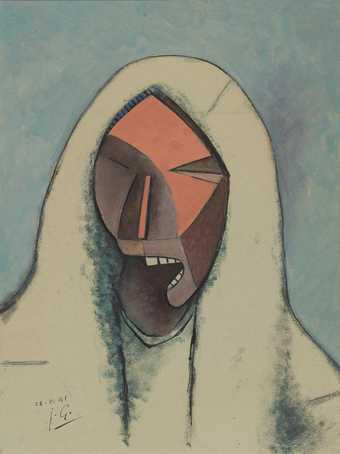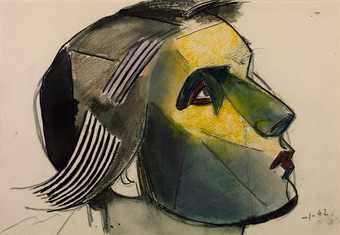Not on display
- Artist
- Julio González 1876–1942
- Original title
- Tête dite 'Le Tunnel'
- Medium
- Steel
- Dimensions
- Object: 467 × 216 × 308 mm
- Collection
- Tate
- Acquisition
- Purchased 1972
- Reference
- T01698
Display caption
González is regarded as the pioneer of welded iron sculpture. He learned oxyacetylene welding while working at the Renault car factory during the First World War. The tensile strength of iron allowed him to create three-dimensional forms without filling in the volume, an effect that he described as ‘drawing in space’. Many of his works show a concern with the human figure, often in a highly abstracted form. In this work, a cylindrical head is placed above a trapezium neck, with suspended triangles to indicate features.
Gallery label, April 2012
Does this text contain inaccurate information or language that you feel we should improve or change? We would like to hear from you.
Catalogue entry
Julio González
1876-1942
T01698 Tête dite 'Le Tunnel' (Head called 'The Tunnel') 1933-4
Not inscribed
Iron, 18 3/4 x 8 1/2 x 12 1/8 (46.7 x 21.8 x 30.9)
Purchased from Roberta González (Grant-in-Aid) 1972
Exh:
Julio González, Musée National d'Art Moderne, Paris, February-March 1952 (69); Sept Pionniers de la Sculpture Moderne, Hôtel de Ville, Yverdon, July-September 1954 (102); Begründer der modernen Plastik, Kunsthaus, Zurich, November-December 1954 (80); Julio González, Stedelijk Museum, Amsterdam, April-May 1955 (70, repr.); Palais des Beaux-Arts, Brussels, May-June 1955 (70, repr.); Kunsthalle, Bern, July-August 1955 (42, repr.); Musée des Beaux-Arts, La Chaux-de-Fonds, August-September 1955 (42, repr.); Julio González, Museum of Modern Art, New York, February-April 1956 (24, repr.); Minneapolis Institute of Arts, May-June 1956 (24, repr.); Julio González, Kestner-Gesellschaft, Hanover, November-December 1957 (43); Haus Lange, Krefeld, December 1957-March 1958 (43); Museum am Ostwall, Dortmund, April 1958 (43); Städt. Museum Schloss Morsbroich, Leverkusen, May 1958 (43)
Lit:
Pierre Descargues, Julio González
(Paris 1971), p.158, repr. p.41; Josephine Withers, Julio González: Sculpture in Iron
(New York 1978), No.71, pp.57-8, 64, 162, repr. pl.44
Repr:
Vicente Aguilera Cerni, Julio Joan Roberta González: Itinerario de una Dinastía
(Barcelona 1973), pp.268-9, pl.225; Ronald Alley, The González Gift to the Tate Gallery
(London 1974), p.28
The catalogue of the 1954 exhibition at Yverdon includes the following note on this work supplied by Roberta González: 'Made about 1932-33. At a certain period González was very preoccupied with the problem of shadows which he wanted to use in a very individual manner. He therefore had the idea of locating them within cylindrical or conical forms closed at one end in which the shadows made a bold contrast as at the entrance to a tunnel (hence the subtitle of this sculpture). "The Lovers", 1933, "The Couple", 1932, were conceived in the same spirit.'
It has usually been dated between 1933 and 1935, but Josephine Withers, who dates it 1933-4, points out that it falls stylistically between sculptures such as 'The Lovers II' and the open-form constructions such as the Stockholm 'Woman doing her Hair'. The Philadelphia Museum of Art, Gallatin collection, owns a closely related drawing in pencil, crayon, pen and ink dated 1934 and dedicated by the artist to A.E. Gallatin.
Since González's death, it has been cast in bronze by Valsuani by the lost wax process in an edition of four, numbered from 1 to 4, plus four further artist's casts inscribed '0', '00', 'EA' and 'HC'.
Published in:
Ronald Alley, Catalogue of the Tate Gallery's Collection of Modern Art other than Works by British Artists, Tate Gallery and Sotheby Parke-Bernet, London 1981, pp.313-14, reproduced p.313
Explore
- abstraction(8,615)
-
- from recognisable sources(3,634)
-
- figure(2,270)
- body(4,878)
-
- head / face(2,497)
You might like
-
Julio González Maternity
1934 -
Julio González Figure of Terror II
1941 -
Julio González Imaginary Face
1934 -
Julio González Sulky Face
1936 -
Julio González Stern Face
1936 -
Julio González Reclining Figure with a Large Hand
1936 -
Julio González Figure at a Window
1936 -
Julio González Figure with Balls
1938 -
Julio González Head with a Long Neck
1939 -
Julio González Shrieking Head, called ‘The Shriek’
1939 -
Julio González V-Shaped Head
1939 -
Julio González Architectural Figure No. 2
1940 -
Julio González Maltese Face
1940 -
Julio González Screaming Head with a White Veil
1941 -
Julio González Solemn Head in Profile
1942


